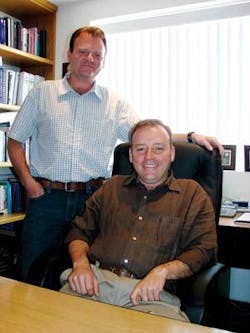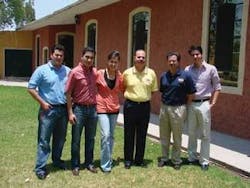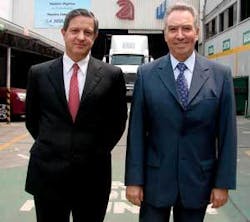Special Report - Mexico: New times, new opportunities - Pt.3
Text and research: Jeroen Posma
Project coordination: Ines Nandin
This supplement was produced by Focus Reports LLC. For more information and exclusive interviews, log on to www.focusreports.net.
The political factor in Mexican oil
The future of the Mexican oil and gas industry will be greatly impacted by the fiscal, legal and regulatory reforms that President Calderon will pass through Congress before the end of his term in 2012. On the day of the election, July 2, 2006, the Federal Electoral Institute announced that the race was too close to call and decided not to reveal the results of its exit poll. After all votes were counted the top two candidates were Mr Calderon with 15,000,284 votes and López Obrador who received 14,756,350 votes. The difference of 243,934 votes resulted in a 35.89% over 35.31% victory for Felipe Calderon, who took office on December 1. Since then, President Calderon’s approval rating has surged to 65 percent, supported by the success of the war on crime and drug trafficking, which he launched by sending thousands of soldiers and federal police to combat well-armed cartels.
Cross-party collaboration will be essential to accomplish President Calderon’s ambitious reform package. Following the deep divisions that erupted after the July elections, President Calderon will have to prove his ability to build agreements in Congress where his National Action Party is the biggest party but lacks a majority. “Changes in the budgetary situation of PEMEX and the relationship of PEMEX with the Ministry of Finance and the government budget can only be achieved through large scale consensus,” confirmed Mario Gabriel Budebo. Mexico’s Undersecretary for Hydrocarbons continued that these changes are not something that can be proposed lightly but will have to be constructed through cooperation between the different political forces in Mexico. In March, Mexico witnessed the first results from cross-party collaboration when Congress passed a pension reform bill, the first major reform approved under the conservative President Felipe Calderon.
The necessity of change is underscored by a recent World Bank analysis of the Mexican economy which indicated that both the tax system and the energy sector are in need of reform. Energy reform, which could include legal reform allowing private investment in the oil and gas industry, seems to be one bridge too far for President Calderon at this moment. A broad public opinion survey conducted last year by CIDE and the Mexican Council on Foreign Affairs revealed that 76 percent of Mexicans oppose foreign investment in oil.
Fiscal reform: a first step forward
With energy reform out of reach, President Calderon has opted to pursue fiscal reform. Six days before the Mexican government presented its fiscal reform plan to Congress on Wednesday June 20, Alan Greenspan, the former Federal Reserve chairman, warned that declining oil output in Mexico could spark a major fiscal crisis in the country. According to Luis Ramirez Corzo, former Director General of PEMEX, the Cantarell field is likely to decline by 14% per year on average between 2007 and 2015. One week after presenting the fiscal reform plan, President Calderon confirmed that he expectes Mexico’s crude oil exports to slip further this year and next, emphasizing the need for a fiscal reform to make the country less dependent on oil revenues.
“Starting in 2006, the volume of our oil exports has been falling at an alarming rate and from what we have observed up until now, this year and the next will be no exception,” Calderon stated at a banking event. In 2006, Mexico’s oil exports decreased by 1.3 percent to an average of 1.793 million bbl/day, largely due to declining production in the Cantarell field. In the first five months of 2007, exports decreased by another 4.4 percent compared to the average 2006 export volume, or 11.4 percent compared to the first five months of 2006, and reached 1.714 million bbl/day. According to official statements, PEMEX has a target to keep oil exports above 1.648 million bbl/day throughout 2007. Nevertheless, the declining export volumes in conjunction with volatile oil prices provide strong incentives to transform Mexico’s dependence on oil and find more stable sources of public financing. “We will do whatever it takes, together with all parties involved, to optimize the energy sector’s positioning as a contributor to economic growth and generator of employment in Mexico. These are the main objectives of President Calderon,” added Mario Gabriel Budebo.
Over the next few months, Calderon will go to great lengths to get the key fiscal reform proposal approved by Congress before September, to ensure its inclusion in the government’s 2008 budget. In addition to reducing Mexico’s economic dependence on oil export revenues, the proposed reform is designed to raise the government’s tax take from 10.2 percent of gross domestic product today to 13 percent by 2012.
While PEMEX’s fiscal contribution has prevented the company from setting an autonomous business strategy, the institutional and regulatory frameworks for the energy sector do not allow PEMEX to attract private investment that would accelerate the expansion of its exploration and production activities. The fiscal reform should enable PEMEX to retain more capital and invest its after-tax revenue in essential exploration and production activities. Between 2001 and 2005, taxation of PEMEX’s revenue has averaged US$3.8 billion more than the company’s pre-tax income. As a result, PEMEX has been unable to increase investment, while according to the Energy Information Administration, PEMEX may need to invest as much as US$32 billion annually in exploration and production to prevent a sharp decline in oil production. The ideal outcome is that Mexico’s three dominant parties - Felipe Calderon’s PAN, Lopez Obrador’s PRD, and the PRI that ruled Mexico for seven decades until 2000 - agree on a viable fiscal reform that will enable PEMEX to operate like a real oil company while meeting the needs of both the Mexican economy and the Mexican people.
Energy reform and fiscal reform
“Mexico needs both a fiscal reform and an energy reform,” stated Francisco Salazar. The President of the Comision Reguladora de Energia, Mexico’s autonomous downstream regulatory body, noted that an energy reform without a fiscal reform would result in an open, but very weak sector. “Mexico needs a strong NOC that is internationally competitive and enters into strategic alliances with other IOCs,” he added. “Of course you could open the energy market without doing a fiscal reform but it will be a waste of money and is probably not in the best interests of the country. On the other hand, a fiscal reform without an energy reform is a perfect recipe for inefficiency. You would not have competition in areas where it would bring efficiency; you would not have diversification of risk and there would not be sufficient investment. Even if PEMEX had more resources from now on, would they be willing to run all the risks by themselves? I don’t think so.” This underscores that the proposed fiscal reform is a step in the right direction, but not yet a giant leap forward for the Mexican oil and gas industry.
A legal perspective
Mexican law firms specialized in the oil and gas industry look beyond the fiscal reform to the potential energy sector reform that would have a much larger impact on their clients. “PEMEX’s monopoly restricts the development of the sector,” confirmed Marcelo Paramo-Fernandez, Partner at Haynes & Boone, a Texas-based international law firm. “Something had to be done to open up the industry to make it more reliable, productive, and efficient. You probably know that this issue has been a political battle and for us practitioners it is really frustrating. Political parties are looking after their political agenda rather than the future of the oil and gas industry, or the country. The people in general are not knowledgeable of the problems that this industry is facing, but want to keep the industry under the Mexican ‘national’ umbrella. It’s really unfortunate.”
“Mexico has a legal framework that is quite difficult to understand since parts of the law dates back to the 1930s and 1950s,” noted Jesús Rodríguez Dávalos, Founding Partner of Rodriguez Davalos y Asociados. For example, there is a regulation that states that PEMEX has a monopoly on the transportation of gasoline through pipelines, but the private sector can perform this function with trucks. “I think that we are going to see changes to the legal framework in the near future. Maybe it won’t be a constitutional reform, but Mexico needs a modernization of the law,” forecasted Mr Rodriguez Davalos.” I think the political will is there to make the essential changes to the legal and regulatory framework. This will make a lot of projects financially viable and bankable, projects that Mexico really needs.”
It is interesting to see how the different markets, such as natural gas, have matured over the years. “E&P in natural gas would attract greater interest from the majors if certain small changes would be made in the legal framework,” assessed Mr Rodriguez Davalos. “However, I think that the majors are first of all interested in offshore oil and gas exploration and production activities. I also see a lot of opportunities for small and medium sized firms to do E&P work in the north of Mexico and Tabasco. I think that we could see Mexican E&P companies emerge, as we have seen in South America. Today there is a very large group of Mexican companies that have been providing many types of E&P services to PEMEX. The next step for these companies is to move into E&P as Mexican juniors.”
In anticipation of reform in the energy sector that would open op these opportunities, law firms operating in Mexico will continue to support Mexican and international oil and gas companies in optimizing their development within the current legal framework, while keeping a close eye on the potential implications of an energy reform.
Being both partners and lawyers
“As in any human activity, you must have a lot of experience to be a good lawyer,” started Sergio Beristain Souza. In 1978 he started his career working at the Labour Court. Subsequently, Mr Beristain found a new challenge as an associate, and later partner, at one of Mexico’s established law firms, focusing on important civil, mercantile and administrative cases. While working on labour issues and dealing with the Labour Unions, he started developing a special interest for the energy sector. “In the years, that followed I really explored this sector through all the amendments that changed the energy sector over the past decades,” noted Sergio Beristain. However, it was not before 1999 that he founded his own law firm that is highly specialized in the energy sector: Beristain + Asociados.
“Lawyers practicing in this field could be divided between ex-PEMEX and ex-CFE lawyers on the one hand, and lawyers specialized in the civil, commercial, labour and administrative areas on the other hand,” he stated while explaining the market opportunity that induced him to create Beristain + Asociados. His firm, operating across the entire value chain of the oil and gas industry, strives to mix an energy practice with expertise in civil, mercantile administrative and constitutional litigation, thereby providing a complete service to the energy companies operating in Mexico.
Explaining his competitive edge, Sergio Beristain noted that the thirty years of experience that enable Beristain + Asociados to understand its clients can hardly be matched by former PEMEX lawyers who have a background in a different corporative culture. Sitting behind a desk in his Mexico City office, Mr Beristain emphasized that visiting oil fields, refineries, power plants and construction sites, as well as local authorities, around the country is essential to provide an optimal service to clients in the energy sector. “You have to understand all the aspects that influence the business of your clients and understand how they really work,” he elaborated. “When changes to the legal framework, or a new authority criterion, start to become a headache for our clients, then we are committed to developing a way to resolve these issues with appropriate solutions in accordance with Mexico’s complex legal system.”
As in any country, operating within the boundaries of the law is a prerequisite for long term success in the Mexican market. “We have the key to doing successful business in Mexico, without corruption and with all the benefits of the law and the legal protection that are available,” emphasized Mr Beristain. “I think that any foreign company operating in the Mexican energy sector could be successful if they have the appropriate legal protection and support. We already try to provide this to our clients. We provide solutions to feared issues such as corruption and the complexity of working with PEMEX, CFE, or the Mexican government. Our contribution is really enabling our clients to work in Mexico while avoiding serious problems in their most important projects. For me this is a very important contribution. In the end, we are both partners and lawyers for our clients.”
Using accurate data as a weapon
During his career as a chemical engineer, Javier Sanchez realized that globalization forces Mexican industry to be efficient and competitive, turning technology into an important tool to survive. Before joining OSIsoft, he was working as private consultant in the field of automation and advanced process control. At that time OSIsoft, previously Oil Systems, had already developed its PI System, a software product that gathers, archives, and processes operational data from automation and control systems for delivery to users at all levels of the company for process analysis.
OSIsoft is truly focused on real time platform infrastructure, while automation and process control companies design and build devices to control various processes, some of which require real time data coming from the plant floor. These applications run on top of OSIsoft’s software platform. “PI is robust set of software modules, running on Microsoft infrastructure, designed for secure plant wide monitoring and analysis,” stated Javier Sanchez. The collected real time information can be shared and integrated with other data sources, such as data from financial systems, ERPs or relational databases, to optimize real time decisions. Mr Sanchez, OSIsoft’s Country Manager for Mexico, explained that OSIsoft’s software platform for real time monitoring and analysis is split in three different groups: the server, the analytics and the visuals. “This data collection process allows for the use of accurate data as a weapon and enables our customers to continuously improve their business performance,” he boasted. Predicting problems is difficult because by essence, there might be multiple variables causing them. However, the benefits of preventing problems by using real time and historical data, forecasting, analysing the history of the data, are undeniable. These days, many oil and gas companies monitor their operations with PI.
OSIsoft has implemented its Real-time Performance Management (RtPM) system at PEMEX Exploration and Production (PEP). OSIsoft’s RtPM platform implementation for PEP provided this PEMEX division with the ability to continue to integrate additional products and solutions within the existing enterprise architecture. According to information provided by Microsoft, OSIsoft’s technology partner, the real-time operational data is collected from sensors on well-heads, compressors and pipelines and is integrated with information from control systems, consolidating all operational data into a single location. The RtPM platform at Pemex PEP is transforming millions of data points into powerful role-based information that can be analyzed by equipment, by well, by reservoir, by field, by business unit or by enterprise. This enables team members to access a “single version of the truth” for faster, better-informed decision making.
In addition, PEMEX DCO (Direccion Corporativa de Operaciones) is currently using our technology to monitor the performance of their pipelines, while PEMEX Refining has also implemented our systems,” noted Mr Sanchez. “At OSIsoft’s Annual Users Conference this August, these two PEMEX divisions will be giving presentations showing the way they use our technology and the benefits they have obtained.” In addition to giving presentations, this conference also provides OSIsoft’s clients with the opportunity to talk with representatives of other companies and check if they are heading in the right direction. “PEMEX is eager to know what is new in the market and looks for tools and technologies that may make their job easier and the company more competitive,” added Javier Sanchez. Covering not only Mexico, but also Central American and the Andean countries’ markets from his Mexico City office, he is destined to be a busy advocate of OSIsoft’s technology solutions over the coming years.
Technology transfer: a win-win situation
Santiago de Querétaro, founded in 1531, is the capital of the Mexican state of Querétaro. Its historic centre is a World Heritage Site, while at present, the city of Queretaro boasts more than 30 research centres, making the city one of the most important technological research hubs in the country. One of its most prominent research institutions is CIATEQ, which employs over 500 people. “We are not a basic research centre; we are a technological research centre with a main focus on integrating technical solutions for industry,” started Victor Lizardi. Since he became Director General in 2001, CIATEQ’s focus has increasingly shifted from the automotive to the oil and gas industry. This development was not a coincidence; the energy sector was already defined as a target market a decade ago.
A very important strength of CIATEQ is in fluid flow measurement, which is directly applied to oil and gas flows. In addition, we are a centre of excellence for SCADA systems,” explained Mr Lizardi. Since 1998, CIATEQ has been working with PEMEX and over the years PEMEX Gas has become CIATEQ’s main client, while the research institution completed projects for PEMEX Refining and PEMEX Exploration & Production.
CIATEQ has distinct advantage over foreign research institutions. “As a public research centre we are part of the federal administration, and between federal entities such as PEMEX and CIATEQ there can be an interchange of services outside of the bidding processes”, expanded Mr. Lizardi. “We take advantage of that by performing projects for PEMEX, CFE, ASA (Aeropuertos y Servicios Auxiliares) and another federal and local entities, projects than foster CIATEQ´s technological strengths. In order to meet PEMEX’s needs for large natural gas flow measurement installations, CIATEQ has entered into partnerships with big institutes in the United States and Canada, such as Southwest Research Institute and Transcanada, which complement its capabilities and enable CIATEQ to execute these large projects for PEMEX.
CIATEQ is an interesting partner for large international research institutes, as well as international service providers to the oil and gas industry, because it provides them with the opportunity to introduce their technologies in the Mexican oil and gas industry through direct access to PEMEX and CFE. “While we promote them in Mexico we have access to the state of the art technology and the opportunity to benefit from technology transfer during the development of the projects. This is clearly a win-win situation,” emphasized Victor Lizardi.
Also PEMEX is stimulating international oil and gas companies and service providers to invest in the development of the industry. For this purpose, PEMEX established a technology transfer management division in 1996. Sergio Berumen Campos, Technology Transfer Manager at PEMEX, emphasized that promoting open communication between PEMEX and technology companies is key priority. ”We need new technology. We must reach all companies who offer new and different technologies, and in some cases make investments in specific technologies which we need to develop,” he added. It looks like Victor Lizardi’s win-win situation actually offers triple advantages.
The power of people
CIATEQ pursues the development of products and solutions that facilitate the technological advancement of the Mexican oil and gas industry, but one should never forget that also people are fundamental to the industry’s success.
When Ramiro Guerrero founded Grupo AIH in 2000, his initial ambition was to create an outsourcing company that would provide job opportunities and social stability for the Mexican people. He believed that offering the Mexican people employment opportunities in their own country could deduce their desire to go abroad in the pursuit of financial gain. Based on his employee oriented philosophy, Mr Guerrero consistently strived to developed Grupo AIH company that gives freedom to the Mexican people.
While small and medium size Mexican companies were the first ones to benefit from outsourcing their human resources management, Grupo AIH now also provides its services to international companies that are entering the Mexican market. After having optimized its business model in the hotel industry, Grupo AIH expanded its focus into industries such as wine & liquor and spas. “We are now very interested in the oil and gas industry, especially with the industry’s growth we are expecting,” stated Ramiro Guerrero. “The new President, Felipe Calderon, is pushing Mexico’s economic development and as Mexicans we want to contribute to the future success of the Mexican oil and gas industry. We would be out of business if we did not capitalize on the opportunities presented by the growth of the oil and gas industry, the main driver of the Mexican economy.”
Foreign companies entering Mexico generally do not have a thorough understanding of the business culture, legal framework and fiscal climate. This lack of knowledge tends to raise their operating costs. Grupo AIH supports these newcomers by offering accounting, legal and fiscal support as well as advice on insurance and of course human resources, allowing their clients to focus on establishing their business.
President Calderon recently put in place tax incentives aimed at helping young professionals and recent graduates to find employment with new companies entering the market. “This is a great advantage for international companies entering the Mexican market since they are able to employ highly skilled people who are acquainted with their business area, full of energy and ready to adapt to the international culture of such companies,” analyzed Mr Guerrero. “This tax reduction plan for new graduates is a very good incentive that international companies are eager to take advantage of.”
Challenges or opportunities in the pipeline
When benchmarking the condition of PEMEX’s pipeline systems to international standards, one has to be very careful to always recognize that within PEMEX there are significant differences. “The standards of PEMEX Gas in terms of pipeline maintenance and pipeline operation are very good, I would say in some aspects world class,” stated Jesús Reyes Heroles. “Taking advantage of this competence, PEMEX Petrochemicals has passed the management and operation of all its pipelines to PEMEX Gas. However, when you turn to the other two subsidiaries, especially PEMEX Refining, the management and operation of all the pipelines is problematic,” continued Mr Reyes Heroles
He is not the first Director General of PEMEX who is confronted with the necessity to optimize the company’s pipeline maintenance strategy. In 1992 there was a big pipeline explosion in Guadalajara. Apparently, while doing various works, the municipality of Guadalajara caused damage to one of PEMEX’s gasoline pipelines and the fuel spilled into the sewage system causing a terrible explosion. This unfortunate event not only had the positive effect of creating increased awareness about the importance of maintaining pipelines, but also resulted in Miller de Mexico’s first contract with PEMEX to protect a fuel-oil pipeline in Manzanillo.
Within a short amount of time, the company, headed by brothers Jose and Alejandro Gutierrez, was also able to secure a multi-annual contract with CFE to detect and repair gas leaks in the Monterrey Natural Gas Grid, the largest grid in Mexico serving more than 350,000 customers. During the grid assessment, Southern California Gas discovered over 25,000 undetected leaks. With its partners’ technology, Miller Pipeline was able to detect, pinpoint and fix a large portion of these leaks in a safe and cost effective way. “In the 6 years we worked with CFE, our company managed to pinpoint and perform live-repairs of more than 15,000 leaks without a single accident,” noted Alejandro Gutiérrez, Director General of both Miller Pipeline de Mexico and United Pipeline de Mexico.
Since then the company has continued to grow, by leveraging its partner’s technologies, in three main areas of operation and focus. The first area of operations is the construction of utilities and pipelines for natural gas companies - such as Sempra Energy, Gaz de France, and Tractebel - and clients for the telecommunications industry.
The second market is the construction of new pipelines for PEMEX. “We expect important investments to be made over the coming years as more exploration and productions efforts shift from offshore to on-shore,” explained Alejandro Gutiérrez. “On-shore, one of PEMEX’s most promising alternatives is the Chicontepec field, where more than 15,000 wells need to be drilled by some estimates.”
Finally, the third area of focus is the Tite Liner system, a world leading polyethylene lining system for internally protecting oil and gas pipelines from abrasion and internal corrosion. The Tite Liner system was introduced in the Mexican market in partnership with United Pipeline Systems, the subsidiary of Insituform Technologies, Inc. that developed this technology. “Mexico mainly produces oil and gas that is sour or mixed with water. These components provide for huge internal pipeline corrosion problems and create an interesting market for us,” explained Alejandro Gutiérrez. By rehabilitating as opposed to replacing existing pipeline infrastructure, the Tite Liner system has enabled PEMEX to save millions of dollars. “Our relationship with United evolved based on the substantial amount of work we were able to secure with PEMEX installing a system Miller Pipeline decided to discontinue and which led to the creation of United Pipeline de Mexico - a joint venture between Insituform Technologies and our company,” stated Alejandro Gutiérrez.
To install the Tite Liner system in an existing pipeline, the pipeline is cut in sections of up to 1.5 kilometres. Then, a pig is used to calibrate the pipeline and check if it was built correctly, while in the meantime the High Density Polyethylene pipe is fused in equivalent sections. “Once everything is ready, our system is pulled inside the pipeline while compressing the polyethylene liner into the steel pipeline. With our system, the liner has an external diameter which is larger than the internal diameter of the steel pipe. After the liner is pulled, we end up with a compression fit between the plastic and steel pipes,” explained Alejandro Gutiérrez. “Once we reconnect the pipeline, the end result is a steel pipe which is internally protected by a smooth and tight plastic liner which isolates the corrosive product from the steel walls. In terms of speed, the majority of our time is spent preparing the work, but in general it is a fast and cost effective process. It will usually take us a fraction of the time and money to rehabilitate a pipeline with the Tite Liner system compared to what PEMEX would spend building a substitute pipeline.”
Giving a practical example, his brother, José Angel Gutiérrez, Operation Director, noted that last year the company rehabilitated a critical 16 inch, 10km pipeline which transported crude from a production field to a processing plant in Southern Mexico. “In the 3 years since the pipeline was built in 2003, it had already suffered 50% wall-loss due to internal corrosion. The estimate cost of replacing this critical pipeline was estimated at 90 million pesos (US$9 million), and construction was scheduled to take two years due to the complexity of the area. Our company rehabilitated this pipeline in four months for close to 15% of the replacement cost and PEMEX now has a pipeline transporting sour crude, which will give years of trouble free service.”
In addition to rehabilitation, the Tite Liner system can also be applied to protect pipelines that are expected to encounter internal corrosion problems, like water injection lines, CO2 lines and sour lines. “In the case of Chicontepec, for example, PEMEX knows for a fact that there is going to be an internal corrosion issue in many of the new pipelines, so they might as well build them to last,” noted Alejandro Gutiérrez.
“Since our first Tite Liner installation eleven years ago, PEMEX has tried various technologies, ranging from fibreglass pipes to painting the inside of pipelines, to stop internal pipeline corrosion,” noted Alejandro Gutiérrez. “In the end, I believe time has been our best ally. Today, every single meter of Tite Liner installed over the past eleven years is operating without any problems, while many other alternatives have failed to deliver even acceptable results,” he emphasized.
José Angel Gutiérrez also identified the natural gas transport market as a future opportunity. Given the growing energy needs of Mexico, various estimates show that this country will need a minimum of US$5 billion investment in natural gas transport pipelines within the next 10 to 15 years. Along with this, PEMEX’s restricted budget and the pressure it is facing to invest almost exclusively in E&P activities, implies that the market for new natural gas transport pipelines will have to be filled by the private sector. “Given this scenario, we see many opportunities for the construction as well as the ownership of large, medium and small pipeline transport systems,” underlined José Angel Gutiérrez.
Looking for niches opportunities that make financial sense enables the Gutiérrez brothers to target many projects within the US$ 5-15 million range that large corporations would never consider. “How much value you offer and how you are rewarded for it will determine your level of success,” concluded Alejandro Gutiérrez.
Virtues of a family business
“Padre noble, hijo rico, nieto pobre” is a famous saying about family owned business in Mexico. It implies that the noble father is the founder of the business, the son takes over and enjoys the wealth but is not able to grow the business, while the grandson inherits a business that is going downhill and might eventually be heading for bankruptcy. While Miller Pipeline is a first generation company that might become a family business, Heliservicios is a second generation family business that is well on its way towards defying the prophecy of this Mexican saying.
Since their father retired in 1975, engineer Guillermo Ortega Garza and Captain Carlos Ortega Garza have been determined to maintain the family tradition. Their father was involved in a US Petroleum company from La Fayette named Petroleum Helicopters. Using this experience as a stepping stone he started his own business, which got involved all over Latin America. When Guillermo and Carlos took over the business they started with a construction company and identified the opportunity of complementing the construction services with aviation services.
New technology: hydrocarbon leak detection by helicopter
Heliservicios is offering an integral service based on its core activities: detecting pipes, spills and leaks, and maintaining ducts. Using highly specialized helicopters, Heliservicios is able to offer unique services such as aerial geophysics, using magnetometry systems for the preparation of digital mapping of underground pipelines. “Many pipelines are old and no one knows where they are precisely, so we detect them with our equipment,” stated Guillermo Ortega Garza. “Considering the environmental cost of having leaks to the cost of exploration, it is clear that the service we offer is vital for all countries,” noted Guillermo Ortega. “Our mission is detecting hydrocarbon leaks, through the use of radiometry, thereby managing their impact on the environment.”
While Heliservicios’ new technologies have been tested and proven in countries such as Canada and US, Latin Americans still find it hard to embrace the advantages of these innovative technologies. Although a small leak can be transformed into a major problem within few days, Heliservicios is still raising awareness of the efficiency and cost-effectiveness of its technology to increase its industry acceptance. “Our equipment detects the emanation of the hydrocarbon as the helicopter flies on above them. Our GPS detects the positioning, a process that is referred to as geo referencing, and exact data regarding the positioning of the problem is collected,” explained Guillermo Ortega. The pilot and the technical operator cooperate to send real-time information on the pipelines, which allows the duct personnel in PEMEX to take fast decisions. After a problem is detected the location data, as well as pictures and videos of the exact position, are transmitted to the terrestrial that is equipped to repair the pipeline, protect the area, and remove the contaminated soil.
“In the construction of new pipelines, we use the LIDAR system with laser beam technology which digitalizes the geography,” stated Cap. Carlos Ortega Garza. Heliservicios has the capability to conduct 400 kilometres of topographic survey a day. This digital information, which identifies topographic curves with one centimetre precision, can be applied to predict the flow of a crude spill, determine the vegetation density for environmental impact studies and forecast water levels in case of river floods, thereby identifying the optimal route to construct new pipelines and ducts. “We also calculate the height of trees, or electric lines that can impact on the duct or interfere in the construction of it,” added Carlos Ortega. “We provide a digital image of any territory that we can survey with our helicopters, that’s a strong tool.” Environmental impact has also become a major issue in project development, besides the need to consider indigenous people living on certain territories. “Deforestation impact and culture contamination can be contemplated with the information we provide contributed,” Ing Guillermo Ortega Garza.
Besides the application of new concepts and technologies, Heliservicios differentiates itself from the competition through ownership of its fleet of helicopters. Through joint ventures with Canadian partners, Heliservicios stays at the leading edge of technology by introducing the latest advances in the equipment. By considering helicopters as fast and efficient tools rather than luxury means of transportation, Heliservicios has turned its global vision into an international presence based on successful projects in Mexico, Canada, Nicaragua, Panama, Colombia, Peru and Ecuador. “There are many opportunities both in Mexico and around the world,” concluded Carlos Ortega. It seems like the grandchildren of the Heliservicios’ founder will not be inheriting a business heading for bankruptcy - a Mexican saying might be ready for revision.
Lifting Mexico a little higher
After the financial and economic crisis in 1982, which roots lay in the oil boom of the late 1970s, Mexico vowed to make significant investments to establish sustainable economic growth. At that moment, Ing. Reynaldo Santos de la Cruz decided to start his own business. “Two years after the crisis I bought the first crane and began what Eseasa is today, since then we grew in a straight line through hard work and commitment,” he reflected.
Having started operations in the southern tip of the State of Tamaulipas, meeting the specific heavy lifting requirements of clients across the municipalities of Tampico, Madero and Altamira, ESEASA has grown to become Mexico’s leader in heavy lifting. “Through the continuous acquisition of equipment from abroad, Eseasa has become the company with the most modern fleet and the largest cranes in Mexico,” boasted Reynaldo Santos de la Cruz. “Ongoing investment in renovation and maintenance of our equipment ensures that our fleet remains equivalent to the fleets of any European or American company.”
While quality and service have proved to be critical success factors, ESEASA takes particular pride in its ability to offer an integral heavy lifting service. “We provide the engineers, the riggers and all of the equipment,” noted Mr Santos de la Cruz. Rather than charging for each different service, ESEASA works in terms of projects and charges per ton. According to its President, this approach enables ESEASA to always be on time or ahead of schedule. “Our strategy is delivering the best service in combination with the highest safety standards,” he added. “Taking into account the high number and volume of lifts and rigging maneuvers we have completed, our safety record is outstanding.”
In recent years, ESEASA completed several flagship projects that strengthened its reputation in the Mexican oil and gas industry. These included heavy lifting work for the construction of offshore oil platforms and combined cycle thermoelectric plants. “We have started the heavy lifting work for the majority of the thermoelectric plants in the country, together with Alstom, Iberdrola and ICA Fluor. Also, we were involved in most of the work at the petrochemical plants, as well as in the Minatitlán’s refinery reconfiguration, where we are in charge of 75% of the heavy lifting work. At the moment we have around 140 cranes working there,” highlighted Reynaldo Santos de la Cruz. “Our integral service, safety standards, commitment, experience and cost competitiveness have turned ESEASA into Mexico’ preferred heavy lifting partner,” he boasted.
Going abroad, staying Mexican
To pursue even stronger growth, ESEASA is expanding its presence according to the market developments, globalization and free trade agreements. In 1997, Eseasa established its US operations as a supplier for quality lifting accessories, spare parts for machinery and equipment and as a representative office for the international market. After establishing a solid position in the US market the next step will be further expansion in Latin America.
In addition to being a 100% Mexican company, ESEASA is also becoming a family business. “I am looking forward to retiring in the coming years as my sons are taking over the management of Eseasa,” explained Mr Santos de la Cruz. He expects that his sons will encounter great opportunities rather than limits, as they lead ESEASA into the future. “México has to take decisions that will strengthen the oil and gas and infrastructure industries, which are core parts of the Mexican economy. Eseasa will grow together with these sectors, continuing on our historic growth path. I love and trust my country, but we need to work hard to leave a strong and successful México to our children and the next generations. We are ready for any challenge that comes with the future opportunities.”
Scaffolding, from Aztecs to PEMEX
Tenochtitlan, inhabited by 300,000 people in the early 16th century, was built upon an island in Lake Tetzcoco, which at the time occupied a large portion of the Central Valley of Mexico. Today, the lake is drained and the ruins of the Aztec capitol lie beneath downtown Mexico City, but before Hernan Cortés defeated the Aztec warlords in the summer of 1521 it was the political, religious and civic centre of the Aztec empire. In Tenochtitlan, among the royal palace, temples, pyramids, council-houses and other buildings, there stood tall scaffolding bearing thousands of skulls of the Aztec’s enemies. These were offerings to the gods of the Aztecs and served as a reminder of the military power of Tenochtitlan’s Aztec rulers.
At present, scaffolding is still widely used in Mexico, although the Mexican construction and oil and gas industries are putting it to more peaceful use. Operating from its Mexico City headquarters, only several kilometres away from the ruins of the Temple Mayor, the main temple of the Aztec capital of Tenochtitlan, Andamios Atlas grown to become Mexico’s leading provider of scaffolding equipment and services since its foundation in 1965.
Twenty three years ago, Ing. Mario Bertran Marce joined Andamios Atlas. Before 1993, the company was mainly dedicated to the construction business. “When we entered the oil and gas industry we did not lose any market share in the construction business,” recalled Mr Bertran. Despite Andamios Atlas’ diversification into oil and gas, its market share in the construction industry is larger today then it was in 1993. “We maintained that business with specialized shoring and formwork equipment, while we added specialized business lines like scaffolding for offshore platforms and petrochemical plans, which we call ‘total systems’, “ continued Andamios Atlas’ former Director General. Andemios Atlas gradually diversified its products and is currently collaborating with PEMEX to optimize the utilization of specialized scaffolding for the maintenance of petrochemical plants and offshore installations.
Back in 1993, Andamios Atlas was the first company to introduce these kinds of systems in Mexico in response to PEMEX’s interest in raising the security level on its platforms. “In the past, PEMEX was using just ropes and wooden structures to reach remote locations on the oil rigs for maintenance work,” explained Mario Bertran. “We designed special applications for different parts of the oil rigs. Nowadays, PEMEX requires all contractors and sub-contractors to use our systems and, of course, we are the main suppliers of this kind of equipment to PEMEX.”
These developments took place before Jorge Larrea Molina was appointed as Director General of the company, following in the footsteps of his father who was one of the founders of the company. He now oversees a company that has two special divisions, the scaffolding division and the shoring equipment division. Its sixteen branches cover all Mexican territory. Andamios Atlas, which is ISO 9001:2000 certified, has particularly strong branches in PEMEX’s special development areas. “About 85% or 90% of the income of our key branches in Villahermosa, Coatzacoalcos, Ciudad del Carmen and Altamira comes from PEMEX and companies related to PEMEX,” confirmed Mr Larrea. “Our distribution network and on-time delivery, in combination with the engineering service that we provide, give us a competitive edge over our competitors,” he continued.
About 25% of Andamios Atlas’ net income comes from selling equipment, which implies that the rental business, which is made up of 40% total systems and 60% construction industry, still dominate the company’s activities. Ing. Mario Bertran Marce has a clear vision on the rent or buy trade-off that his clients are facing. “Everybody has to do what they are supposed to do,” he stressed. “Our clients have to produce oil and we want them to produce oil, and they want us to build the scaffolding. That is the reason why we recommend renting. It is more efficient for our clients and it is much more efficient for us.”















